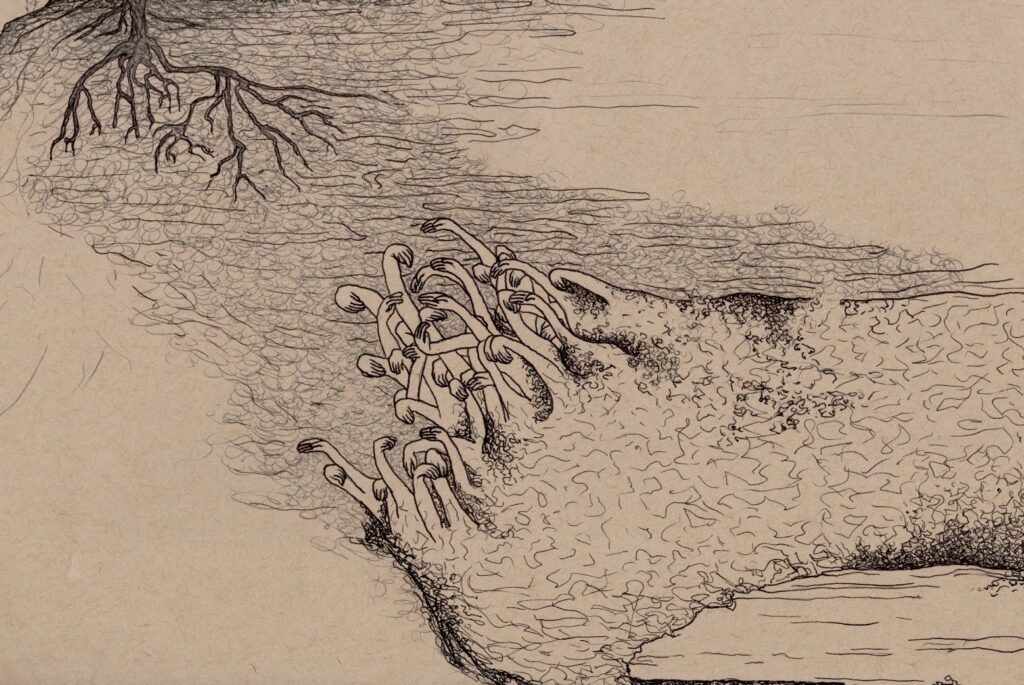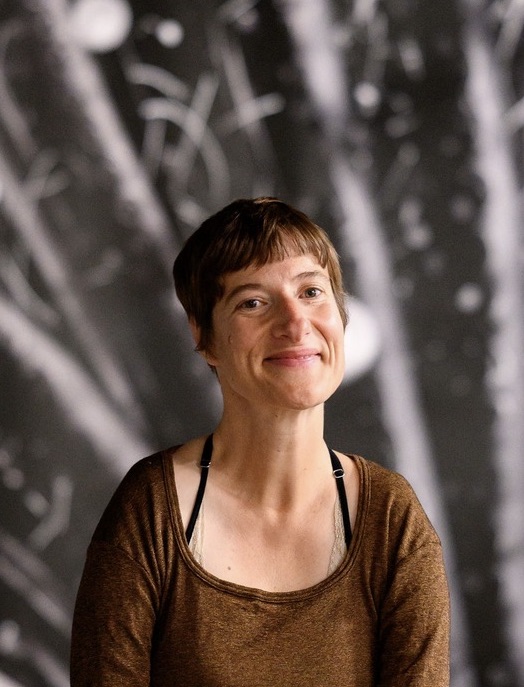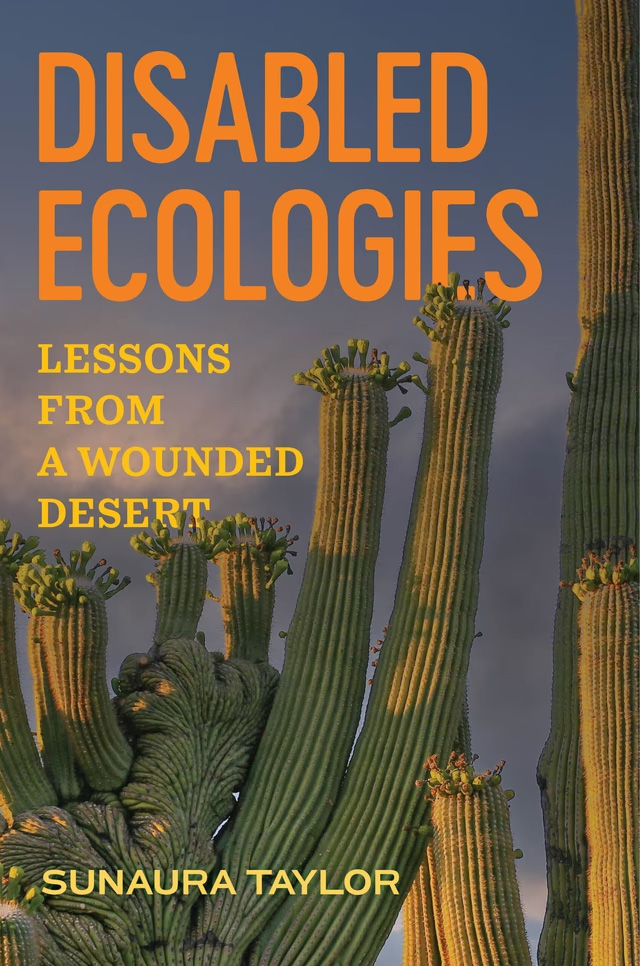Can an Aquifer be Injured? Scholar Brings a Disability Lens to Ecological Repair
In her new book Disabled Ecologies, UC Berkeley professor Sunaura Taylor returns to a Tucson Superfund site to document how residents organized one of the earliest and most successful environmental justice movements in the country.

Sunaura Taylor
In the early 1950s, Hughes Aircraft Company and other defense and electronics industries began dumping toxic chemicals in the desert near Tucson’s southern border. For decades, these chemicals seeped into the aquifer that supplied drinking water to the city, creating a plume of contamination that eventually reached the taps of residents on Tucson’s south side.
By the time the dumping came to light in the 1980s, thousands of lives had been impacted by the tainted water, including that of Sunaura Taylor, a UC Berkeley professor, writer and artist. Taylor was born disabled on the city’s south side and grew up with the understanding that her disability could likely be traced to the contaminated aquifer.
In her new book, Disabled Ecologies, Taylor returns to Tucson to explore the history of the aquifer through the lens of disability. The book documents the tireless work of residents from the south side’s largely Mexican American community, which organized one of the earliest and most successful environmental justice movements in the country. Along the way, Taylor grapples with human injury, environmental harm, and why these two concepts are often separated in our minds and institutions.
In a recent interview with Berkeley News, Taylor discussed the importance of resisting ableism in environmental movements, why we need more disabled scholars in research, and how painting helped her find love for an aquifer.
Berkeley News: Could you give some background on the contaminated aquifer in Tucson’s south side?

Courtesy of Sunaura Taylor
Sunaura Taylor: Various defense and electronics industries moved into Tucson after World War II. As soon as these industries opened, they started dumping all sorts of contaminants in the desert, including huge amounts of trichloroethylene (TCE), an industrial solvent. The major polluter was Hughes Aircraft, which later became Raytheon, now RTX. They are to this day an extraordinarily powerful producer of all sorts of weapons technologies.
The pollution eventually seeped into the groundwater and ended up in people’s wells, in their drinking water. A lot of people in the largely Mexican American community became sick. Later studies would find disproportionate levels of cancers, illnesses like lupus, and congenital disabilities [among residents of Tucson’s south side]. It wasn’t until 1985, when a local journalist named Jane Kay worked with the community on an investigation, that the contamination came to light.
The story blew up. Within a few months, an amazing movement —Tucsonans for a Clean Environment (or TCE, named after the main contaminant) — was born. There was this realization that not only had this pollution been happening for decades, but that even once they knew about it, the city hadn’t investigated who received polluted water. Instead, city officials started blaming the community, saying that their “lifestyle” and “diet” made them predisposed to illness. These very racist, ableist accusations were part of what made the community come together in response.
The movement was remarkably successful from the beginning. They had this expansive vision of justice — one that was directed toward both care for the land and the aquifer, and care for people, and that challenged systemic harms.
What motivated you to return to Tucson and write this book?

I always knew I wanted to return to Tucson and write about the Hughes pollution. I say “return” because my own personal story is connected to this history: I was raised with the understanding that my disability was caused by the contamination. This book is not a memoir, but my personal story is important to the project because it offered me, growing up, a way of thinking about disability and the environment together. I understood that disability wasn’t just my own individual medical problem, but something profoundly political that can impact a whole community, and that can be caused by systems of harm and exploitation — war and pollution and environmental racism.
I also had an understanding that nature isn’t separate from us; that humans are part of nature. I had a visceral understanding that injury to the environment is injury to people. These insights are the kinds of things that would later shape my perspectives on disability and the environment. When I began this book, I knew I wanted to make the case for the importance of bringing disability into the environmental conversation. It made sense to me to return to Tucson and root my exploration in that place and in history that had shaped me, both physically and intellectually.
When I moved back to Tucson in 2017 to do my field work, there were many things that surprised me, including learning about this amazing environmental justice movement. I was also surprised by how much the aquifer became such a compelling character in the story to me. Getting to know the aquifer became really central, and I increasingly saw the aquifer as a companion, as injured disabled kin.
Why is it important to bring a disability lens to environmental work? What can we learn from thinking about ecologies as injured or disabled?
Disability is already everywhere within the environmental arena, but it’s often unmarked and not critically engaged with. We know that disabled people are on the front lines of nearly every stage of ecological disaster, and we also know that environmental harm — whether we are talking about pollution or climate change — causes disability and illness. But disability is also present beyond the human, both in the stories that we tell about environmental harm and the material reality of what’s happening to our environments. Think of the many arenas of environmental science that focus on ecosystem health, for example. Environmentalists and ecologists work toward healthy environments for healthy people. But what is health, and what is a lack of health? What language can we use to articulate what we and our ecosystems are experiencing, currently?
Whether we want to talk about it or not, whether we are ready for it or not, disability is going to be an increasing part of our environmental reality.
Prof. Sunaura Taylor
We are living in a moment of mass, multi-species disablement. Whether we want to talk about it or not, whether we are ready for it or not, disability is going to be an increasing part of our environmental reality. My hope is that this book can help give us a language, and even more importantly, a disability politics, to begin grappling with this fact. In particular, it seems urgent to me that we bring the insights and work of people who have been living with disability and illness and thinking critically about disability, into our ways of thinking about and responding to environmental harm.
The fields of ecofeminism, Black ecologies and Indigenous ecologies have already shown us how social formation and power dynamics shape how we engage with nature and environmentalism. I think that there’s been less work doing the same thing for disability. But disability is already there, and it needs to be politicized.
Your book highlights how many U.S. institutions, including the government, nonprofits and higher education, have created a divide between ecological health and human health. Can you describe how this divide played out in Tucson’s south side? What can we gain by bringing these fields together?
When I returned to Tucson, I started attending the meetings of a group called UCAB, the Unified Community Advisory Board, which is sponsored by the U.S. Environmental Protection Agency and has been running for at least 20 years. The goal of the meeting is to bring the community together with the polluters and with EPA and state officials to talk about remediation efforts.
What I noticed right away is that there would be people at the meetings who had been impacted by the pollution — who had experienced illness themselves, whose family members were sick, or who had lost family members — and they would ask, “What about us? We are still sick, and we need health care.” And even when empathetic, there would be no real way for UCAB board members to respond because community health care isn’t part of their charter. It is only focused on environmental remediation.
What I quickly realized was that this separation between public health on one side and environmental remediation on the other side isn’t intuitive and doesn’t make sense to the people who are actually living these realities — in fact, it harms them. Why should environmental remediation stop at the threshold of the human body? There was a sense of, “We need to care for the aquifer, and we need to care for the people, too.”
The idea that our health is inseparable from the health of our water, from the health of our forests, is so basic and intuitive. And yet, it has been legislatively, bureaucratically and institutionally torn apart.
Prof. Sunaura Taylor
I started investigating this separation between human health and environmental remediation and found that before the EPA was formed, a lot of environmental departments were actually housed within state health departments. With the EPA, there came a separation between these arenas. Even the original framers of the Superfund program itself envisioned a victims compensation fund, which would have essentially been a fund for human health. But this, of course, was one of the very first things to be cut.
The idea that our health is inseparable from the health of our water, from the health of our forests, is so basic and intuitive. And yet, it has been legislatively, bureaucratically and institutionally torn apart. Thank goodness there have been environmental justice movements that have done so much to bring them together, but there’s still a lot of work to do.
As we face the climate crisis, what other lessons can we learn from the organizers in Tucson’s south side community?
One of the most prevalent ways that you see disability taken up in environmental discourse is as a scare tactic. Disability is framed as something we’re afraid of and which creates economic burdens. This messaging can feed into all sorts of ableist stereotypes. In addition, this approach often does not function to make the lives of those who are disabled better. Instead, it functions to shore up and protect the ablebodied who remain. One of the main things my book is trying to do is to say that it’s not enough to point out that disability and illness happen. What is important is how we respond to this disablement. Do we respond with ableism, or do we respond in a way that centers care and interdependence and disability liberation?
One of the politics that I see in the south side is a resistance to these ableist ecologies and ideas of abandonment. Organizers on the south side are saying, “We’re still here, and the aquifer is still here, still sick, still in need of treatment and health care. The story hasn’t ended.”
Another thing that I see is a real attention to the systems of violence and exploitation — the racism, the war industry, the ableism — that caused the contamination in the first place. This community was calling for the resignation of racist city officials and for polluters to be held accountable, and for greater groundwater protection laws. Their vision of justice was expansive.
One element of the book that I found especially compelling is your attempt to understand and relate to Tucson’s contaminated aquifer. What first intrigued you about the aquifer, and what is your relationship with it now?
I truly love the aquifer. My background is as an artist, and my book prior to this one was about disability kinship with non-human animals. So I’ve been interested in multispecies thinking for a long time.
Early in the project, I realized that the aquifer was the central character of everything I was reading, and yet I really didn’t know what an aquifer is like. And so I started a practice of drawing my evolving understanding of what an aquifer is, starting with the aquifer’s role as part of human infrastructure and then shifting to its role in ecological systems. I include these images in the book in a section called “Speculative Aquifers.”
The nuts and bolts of making particular fields accessible will take creativity, work and innovation. But the No. 1 thing that I think it takes is a recognition that disability is relevant to every single field.
Prof. Sunaura Taylor
For me, drawing and painting is a place to make connections that in another context might seem disconnected. It’s a space of exploration, of letting ideas rub up against each other. This exploration can lead to insights that I otherwise wouldn’t have had. What emerged from my aquifer practice was an understanding that all aquifers are speculative.
One hydrologist who I interviewed said that understanding aquifers is essentially like understanding outer space. We can gather bits and pieces about what an aquifer is doing — where the water is moving, what the sediments are doing, and where contaminants might be going. But really, so much of it is inferred because it is inaccessible to us. It is an act of imagination. And yet, we are so dependent on aquifers. A huge proportion of the population depends on groundwater. Perhaps because they are so hard to imagine we understand them mostly as infrastructure, which benefits those industries that exploit them.
What are some steps we can take to help ensure that more disabled people have the opportunity to engage in environmental research?
If this book can get a few more disabled people, or people who have critical disability studies perspectives, interested in studying climate change or biodiversity loss, or river sciences or forest health, I’ll be happy.
The nuts and bolts of making particular fields accessible will take creativity, work and innovation. But the No. 1 thing that I think it takes is a recognition that disability is relevant to every single field. And when you don’t have a critical disability perspective in your wildlife department, or microbiology department, or [in] any other field, you’re not going to be asking questions that could potentially transform that field.
We know that as a more diverse array of scientists have entered into environmental work, our understanding of other species and of our environments has deepened and transformed. Making these fields accessible and bringing disability into our research will only make us better scientists.
